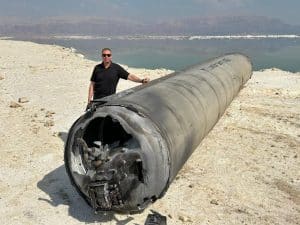Throughout the universe, there is an infinite number of stars and planets. In the Milky Way galaxy alone, where we are located, there are at least 400 billion stars and 100 billion planets and our planet, Earth, is just one of them. Hundreds of billions of stars and planets, some with more suitable conditions and some with less suitable conditions to the existence of life.
According to science today, the only place we know of on which intelligent life exists is our planet, Earth. In fact, there is no hint or sign indicating that there is, or ever was, life anywhere else. Isn’t that a rather odd statistical coincidence?
What are the chances?
If I leave my house and head out to work and suddenly discover I have a flat tire, I would assume that, in all likelihood, I ran over a nail. If, on the next day, the same thing happens, I would probably assume it's merely an annoying coincidence. But – if EVERY morning, when I leave for work, for an entire week, I discover that I have a flat tire day after day, I will no longer assume it is a mere coincidence, but rather outside intervention: Someone is deliberately making sure that I will have a flat tire.
We all encounter coincidences throughout our lives. But when there is a large number of coincidences simultaneously, we can assume that they are not coincidences at all, but rather outside intervention.
If, one day, I should walk into a hotel room and suddenly see my clothes there, my favorite food, paintings by artists I like, where the alarm clock is already set to the time I need to wake up and the air conditioner is set at precisely my preferred temperature, I would know that someone had prepared the room specifically for me before I was there.
A planet prepared for us
We would like to examine a few individual cases out of thousands of “coincidences” in the cosmological world, regarding the necessary prerequisites for the existence of life on Earth which suggest that these are not coincidences at all, but rather outside intervention that has prepared the world specifically for us.
- The distance between the Earth and the sun is roughly 150 million kilometers. The average temperature on the surface of the sun is roughly 6,000 degrees Celsius. Scientists agree that if the average temperature had been higher, even by a mere 50 degrees, or if the Earth were closer to the sun – the water would evaporate and all life on Earth would be wiped out. On the other hand, if we had been located slightly farther from the sun, or if the average temperature on the surface of the sun was lower, it would have caused the water to freeze, leading to all life on earth being wiped out. Therefore, the temperature of the sun and its distance from us enable life on Earth.
- Earth revolves around the sun at a speed of roughly 29 kilometers per second. If Earth were to slow down to, say, 10 kilometers per second – all living things would burn. If the Earth's orbit around the sun was faster, say, 60 kilometers per second – our planet would deviate from its course into the cold outer space, and all life would soon become extinct. Earth completes a single rotation per day, ensuring that we don't burn during the day or freeze during the night. It rotates about its axis at a speed of 1,670 kilometers per hour. If it were to rotate any slower, every form of life on Earth would cease to exist, as it would either freeze at night or burn from the heat throughout the day. If, for example, Earth would rotate at a pace of 167 kilometers per hour, the days and nights would have been 10 times longer. The heat during the summer would rise to the point that would not allow the existence of any living things. The temperatures throughout the winter time would drop hundreds of degrees below zero and no life form would be able to survive. In fact, if the average annual temperature on Earth would either rise or drop, even by only a few degrees, most life forms would cease to exist. The change would disturb the ratio of the water quantities and areas to the amount of ice, and lead to devastating consequences.
- Earth is slightly tilted on its axis at a 23.4 degree angle. This tilt helps balance the amount of radiation emitted by the sun. If, for example, it had been tilted at an 80 degree angle, we wouldn’t have four seasons in a year. Without the seasons, life would vanish. The North and South Pole would be shrouded in perpetual twilight. Water vapor from the oceans would be carried by the wind towards the north and the south, and freeze as they approach the Poles. Over time, giant continents made of snow and ice would form around the Poles and cause most of Earth's surface to become deserts. Eventually, the oceans would vanish entirely and the rains would stop. The weight of the ice accumulating at the Poles would cause the equator to expand and, as a result, the Earth's spin would drastically change, leading to further negative effects on all of Earth's existing life forms.
- The moon's existence, size and location in relation to planet Earth, enables life on Earth. If the moon were larger, or were to suddenly draw closer to us, the oceans would flood a large portion of the low and flat beaches. For example, if the moon was 84,000 kilometers away from us, rather than 384,000 kilometers away – the tides along many coastlines would have reached the height of tall mountains, causing hurricanes. If the moon were smaller, or were to suddenly move farther away from us, the tides would become too weak to maintain the flow of oxygen throughout many areas of the ocean which reach the beaches. Thus, they would affect the underwater life and the entire food chain.
- Earth's diameter is about 12,742 kilometers. Let's say that Earth's diameter was 15,000 kilometers. Gravity would increase, causing a series of chain reactions: The weight of the air would increase, and as a result, the volume of water on Earth would also increase. The ocean water levels would rise, flooding vast areas of the planet. On the other hand, if Earth's diameter was 10,000 kilometers, gravity would decrease, allowing the atmosphere to disperse and evaporate into outer space. The existence of life would have been impossible and meteorites would pummel the Earth.
- The waters in the oceans keep Earth's temperature stable. These waters have special virtues:They absorb large amounts of heat, without significantly changing their own temperature. If there weren't such vast amounts of water on Earth, the differences in temperature between the daytime and the nighttime would be much more significant. If the level of the ocean waters was lower, the summer would be hotter and longer. In many places, the surface of the ocean would have been so hot that eggs could be boiled in it during the day and at night, it would have been so cold that the water would entirely freeze. If the level of the ocean waters were higher, the carbon dioxide in the air would be absorbed, and many plants, which are the main source of oxygen, would perish. If it were not for this amount of water on Earth, life would not be possible.
- The thickness of the Earth's crust is JUST right. Scientists discovered that, if there were just 3 meters more of solid matter on the surface of the entire planet, all of the atmospheric oxygen would oxidize. Considering that Earth's diameter is roughly 12,742 kilometers, the fact that a mere 3 meters would make such a huge difference makes you wonder about the idea that the Earth's crust reached its current size coincidentally.
- The atmosphere on Mars and Venus is made up of roughly 90% carbon dioxide, whereas the Earth's atmosphere is made up of about 21% oxygen, 75% nitrogen, and a very small amount of carbon dioxide. What keeps this gas compound at the ratio which is “coincidentally” vital to the existence of life? Consider the oxygen level: 21%. If the level were, say, 25% – forests would be unable to grow due to fires which would start during every lightning storm. If the level of oxygen were suddenly only 2% less, we would all suffocate to death. If the level were 10% higher, the entire Earth would explode in a giant fireball.
- Dark Energy: if the force of the Dark Energy in the universe was stronger than it currently is, the universe would explode into pieces. And there would be no way for galaxies and stars to exist, not to mention life.1
These were just a few short examples which must all exist simultaneously and work in perfect synergy with one another. But remember: there are THOUSANDS of processes and conditions which must all exist simultaneously and perfectly, in order for any life on earth to have been made possible in the first place. As far as science has discovered, out of all the billions of stars which exist in the universe, there is not one single planet with similar conditions to that of Earth. So, perhaps it is logical to conclude that there IS some outside intervention that has planned the world specifically for us before we were here.
It's no wonder that King David announced:
“The heavens declare the glory of God, and the sky shows His handiwork..” Psalm 19:2
- Robert R. Caldwell and Marc Kamionkowski, The Physics of Cosmic Acceleration, Annual Review of Nuclear and Particle Science, Vol. 59:397-429 (Volume publication date 23 November 2009) First published online as a Review in Advance on June 23, 2009 https://doi.org/10.1146/annurev-nucl-010709-151330
Read more about Fine-Tuning Parameters: https://www.discovery.org/a/fine-tuning-parameters/
.














